Fish can be very sensitive to changes in their environment and can become stressed easily. A crowded pond or tank, the presence of an aggressive fish, or even an environment that doesn’t meet their needs can lead to a high degree of anxiety.
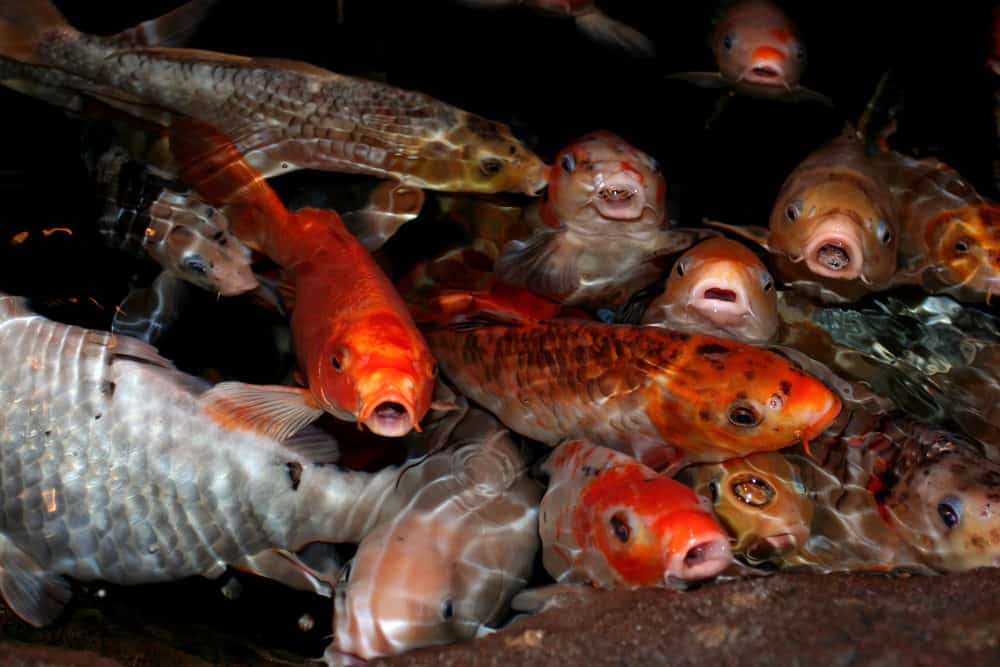
Whether you keep koi fish or another type of fish, it’s important to learn to recognize common stressed fish symptoms so you can address the issue and maintain a koi pond with healthy fish.
Lethargy is a common sign of stress in fish. It often indicates that the water condition is poor or that the water temperature isn’t optimal.
A lethargic fish might lay at the bottom of a tank and not get out of the way when another fish approaches.
Koi fish will thrive in water that is between 65 and 75°F. If the water is too cold or too hot, fish could become lethargic since oxygen levels might become insufficient. In some cases, a disease or bacterial infection can cause the affected fish to become lethargic.
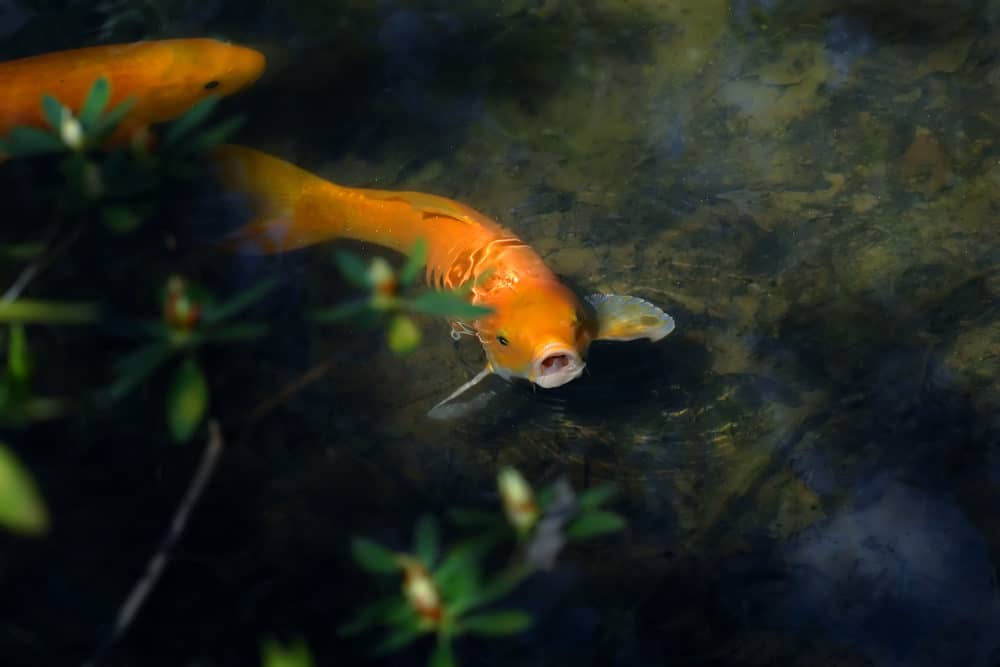
Not eating is one of the top stressed fish symptoms to watch out for. Fish will often lose interest in food when you transfer them to a new tank or introduce a new fish into their environment. However, a sudden change in water quality could also cause a loss of appetite.
This symptom is usually easy to notice since fish will stop coming to the surface to eat. You should also monitor nitrate levels since uneaten food will rot in the water and cause nitrate levels to go up. If your fish stops eating, you should see changes in the nitrate levels.
Fish might not want to eat because of stress, but some fish will not eat if you don’t offer the right kind of food. Young koi fish usually prefer flake fish food while medium-sized koi fish need pellets. Fish food bars are the best option for larger koi fish.
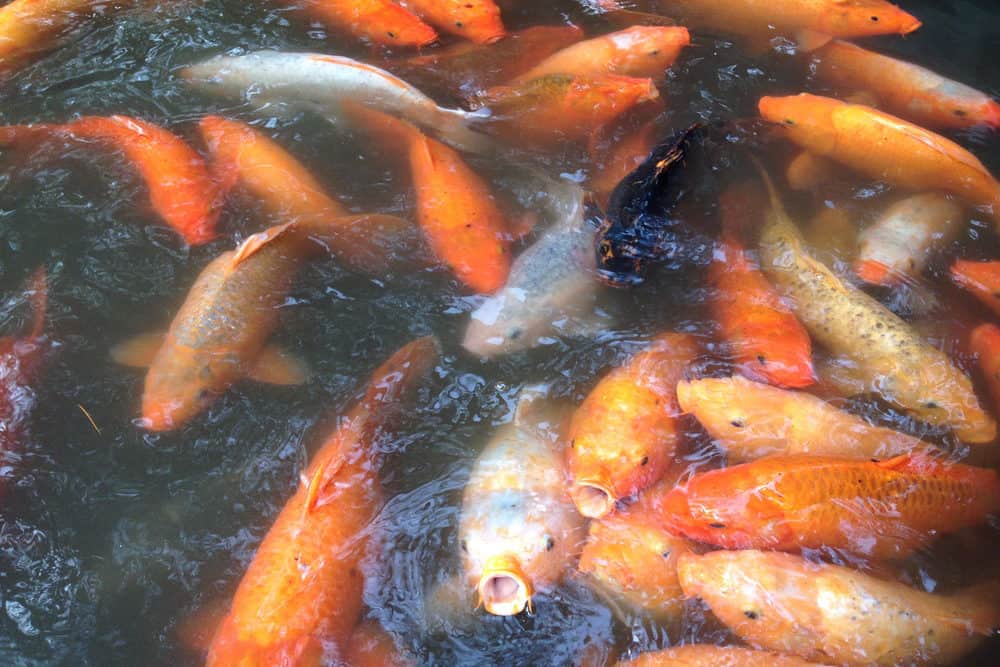
A good rule of thumb is to feed once a day. Offer a quantity that corresponds to what the fish can eat within five minutes. If you overfeed, finding leftovers floating in your tank or pond is normal and isn’t a cause for concern, but you should remove any uneaten food to keep the water clean.
If your koi fish has lost interest in eating, try offering some live food such as worms, tadpoles, shrimps, or larvae.
If oxygen levels drop, pond fish will often swim to the surface and appear to gasp for air. However, this behavior is normal in gouramis or Anabantoidei fish. These fish have a special organ known as a labyrinth that is somewhat similar to our lungs and can breathe at the surface.
Koi fish don’t have a labyrinth, but they will sometimes gulp air from the surface to replenish their swim bladder. This organ helps maintain their buoyancy when they swim.
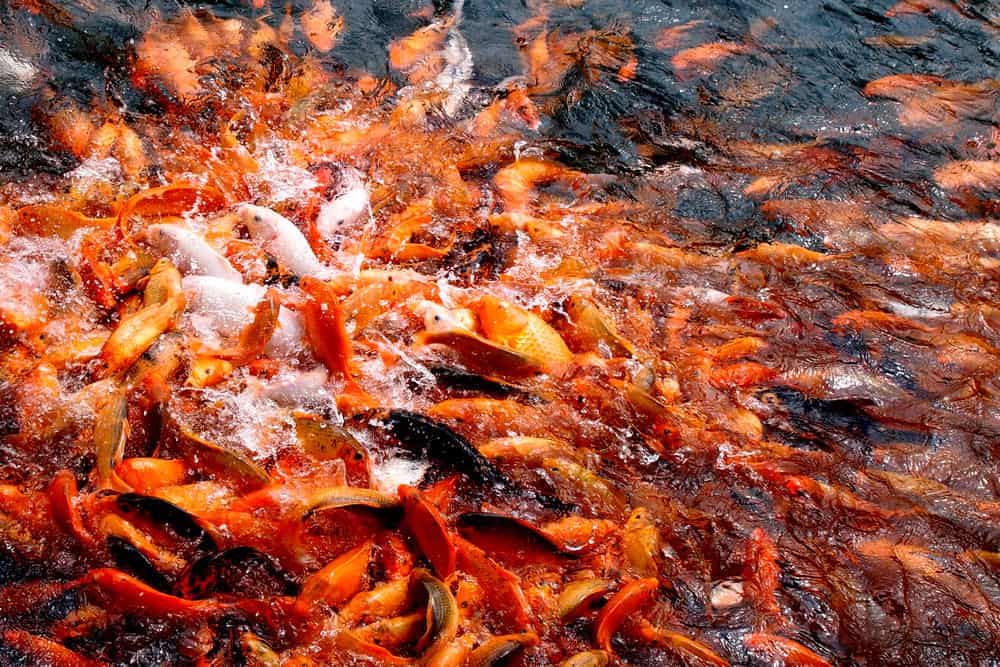
If you see your koi fish gulping air at the surface frequently and notice other signs of stress, you should use a dissolved oxygen meter to check oxygen levels in the water. Ideally, there should be more than 8 ppm. You can increase the dissolved oxygen level by using an aerator or by introducing more plants.
You will probably notice that your fish are opening and closing their gills faster if oxygen levels drop. Note that breathing depends on activity levels. It’s normal to see your fish breathe faster in the spring and summer when they’re more active.
Increased gill movements can also be the result of a bacterial gill disease. You might be able to see erosion and damage to the gills in some cases.
Stress can wreak havoc on a fish’s immune system and lead to stressed fish symptoms. If your koi fish live in an environment that isn’t right for them for a long time, they will become vulnerable to fish disease and parasites. If most of the fish you keep have signs of diseases, there are probably some stressors in their environment.

Diseases and protozoan parasites can cause a wide range of symptoms for infected fish:
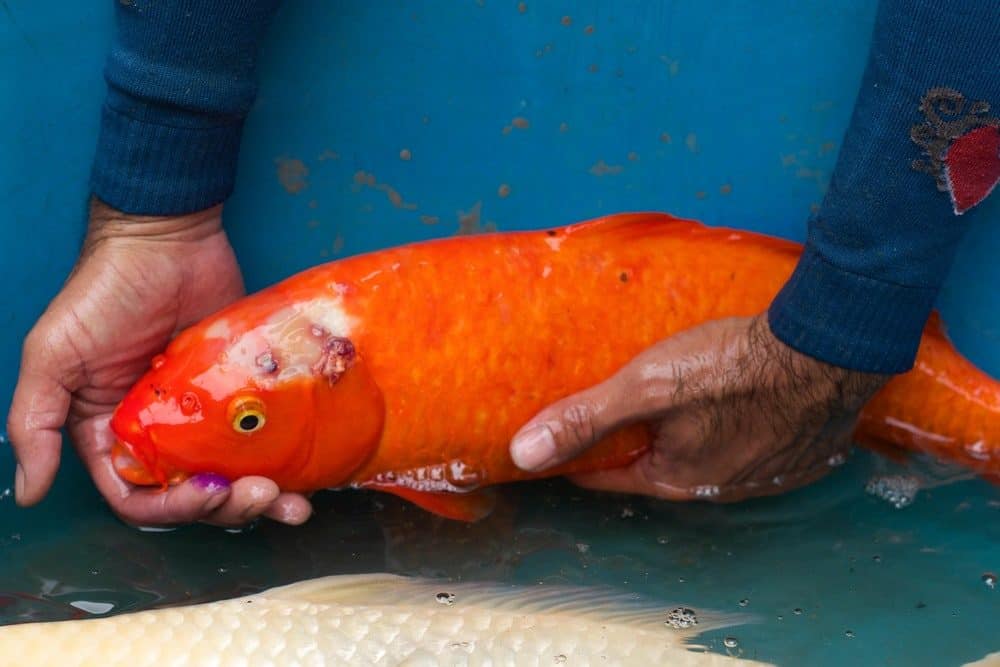
It’s best to contact a veterinarian who specializes in fish if you notice any of these symptoms. You should also isolate the fish that looks sick since diseases and parasites can spread quickly.
If you notice signs of stress that seem to spread to more fish as time progresses, you’re very likely dealing with a disease or with parasites.
Koi fish can lose their color naturally. These fish often develop discoloration as they get older, and it’s common to see females lose some of their colors during the spawning season.
Most koi fish will go through color changes as they grow. It usually takes three to four years for them to get their definite color palette and color changes during their first years are not necessarily a sign that the fish is experiencing stress. A fish’s gene pool can also cause discoloration.
Koi fish have cells known as chromatophores. These cells contain red, yellow, back, or orange pigments. If the fish is stressed, the pigment concentration will increase instead of spreading over the scales and the fish will appear to lose its colors.
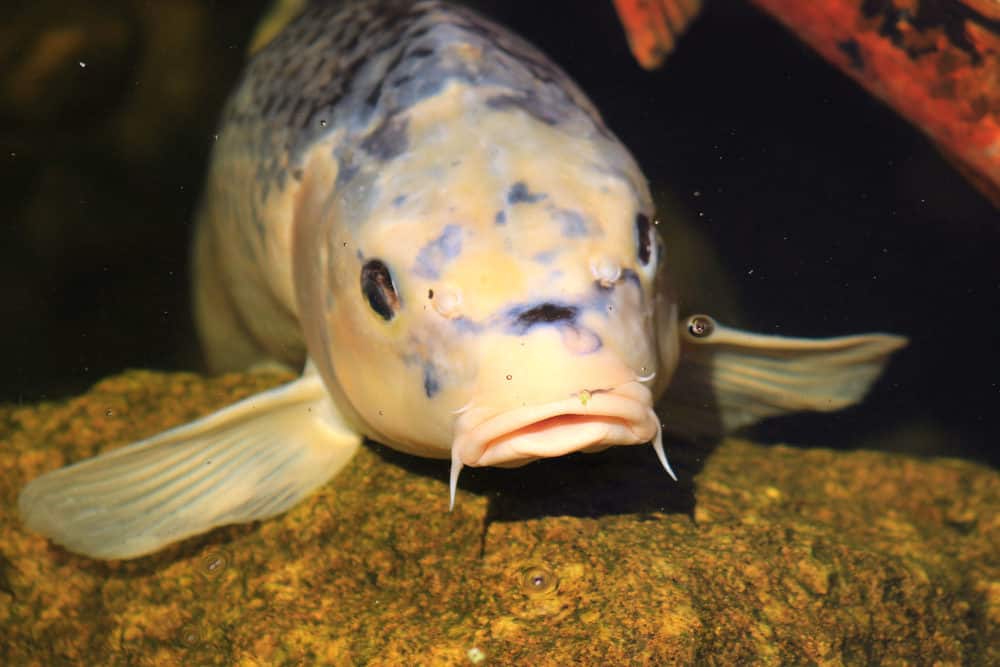
A koi fish can develop discoloration if the water is too warm. A diet that lacks essential nutrients can also cause chromatophores to become less bright. Discoloration can also result from sun exposure or from diseases and parasites.
Many koi fish owners use salt or antibiotics to maintain the water quality and prevent infections in their ponds. However, salt and antibiotics can lead to discoloration.
Discoloration is not necessarily a cause for concern, but you should look for other signs of stress if your koi fish seem to lose their colors.
Stressed fish can display unusual swimming patterns. You might see fish that swim frantically or that don’t have good control over their movements. They might dart, crash against rocks, or sink to the bottom of the pond or aquarium.
Darting can be an attempt to get away from predators and other dangers. However, water that is too hot or too cold can also cause unusual swimming patterns. In some cases, fish will display these unusual swimming patterns due to ammonia poisoning or high nitrate levels.
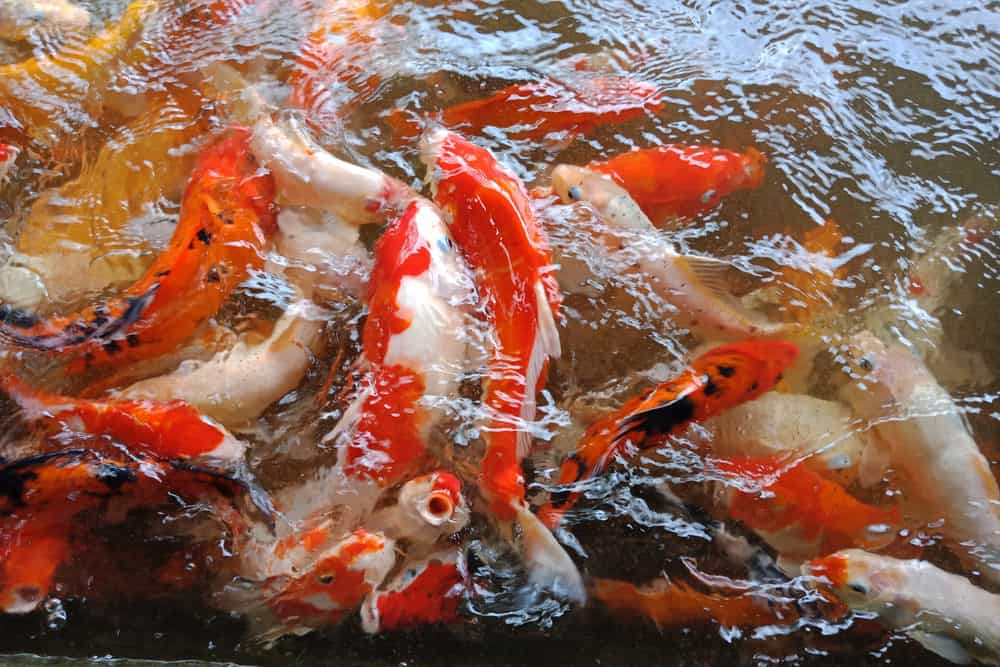
Koi fish aren’t aggressive fish by nature. These fish are usually social and easygoing. However, stress can cause them to become aggressive.
Some fish can display aggressive behaviors if you have too many individuals in your pond or tank. Ideally, you should have at least 50 gallons of water per fish.
Poor water quality, illness, injuries, and not feeding enough or not feeding the right food can cause fish to become aggressive. Koi fish can also become aggressive if you introduce smaller fish to their environment.
Note that males will become more aggressive during spawning season, but it’s not necessarily a sign of stress.
Hiding is a self-defense mechanism. Fish often hide because there is something they perceive as a danger.
Hiding is a normal behavior when you introduce fish to a new environment. Some fish will also hide if you introduce new animals to the tank or pond.
However, excessive hiding indicates that your fish are stressed about something and don’t feel safe in their environment.

For those who keep koi fish in outdoor ponds, herons and raccoons are threats to watch out for. Even local cats can be a stressor for your fish. Predators aren’t always to blame for hiding since some fish will hide if they’re sick or have parasites.
Some fish will also hide to avoid the other fish that may act predatorial. Fish are social animals by nature and hiding from others is a sign that something is wrong.
Note that koi fish kept in outside ponds will become less active during the winter. When temperatures drop, they will enter hibernation mode and eat less. They might also look for spots where they can hide and rest. Hiding isn’t necessarily a sign of stress, especially if it seems to be a seasonal behavior.
Bacterial infections, parasites, high nitrate levels, and pollutants can cause fish to feel discomfort. They will attempt to alleviate this discomfort by scraping their scales against the substrate or against any surface they can find.
Scraping is a natural behavior. It helps fish get rid of foreign objects that might get stuck between their scales. However, a fish that is scraping excessively is likely stressed or has parasites.
You might not notice how often your fish scrapes if you keep them in a pond. However, you can usually see sores and damaged scales if they engage in excessive scraping.
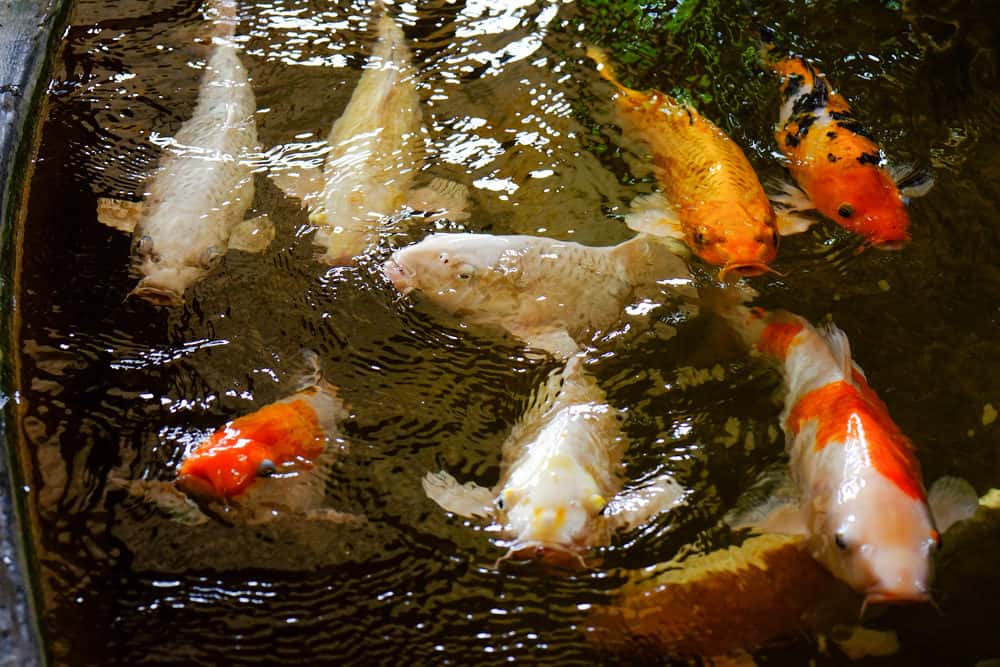
Koi fish spawn once a year for up to seven years of their lives. It typically happens in May or June. They can spawn once they reach two years of age or 12” in length.
If your fish is in a healthy environment, you’ll see some mating behaviors. The females will look swollen because of the eggs, and the males will bump into them until they release these eggs, sometimes aggressively. Once the female releases the eggs, the male will fertilize them.
If the spring comes and you don’t see any of these behaviors, there are likely some stressors that are preventing your sick fish from engaging in spawning.
Keep in mind that signs of stress are fairly common among females during the spawning season. They will often lose some of their color. However, there is nothing to worry about as long as these symptoms disappear at the end of the spawning season.



